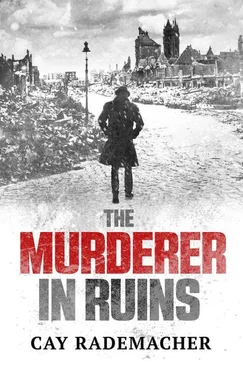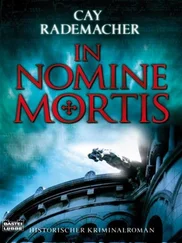Cay Rademacher - The Murderer in Ruins
Здесь есть возможность читать онлайн «Cay Rademacher - The Murderer in Ruins» весь текст электронной книги совершенно бесплатно (целиком полную версию без сокращений). В некоторых случаях можно слушать аудио, скачать через торрент в формате fb2 и присутствует краткое содержание. Год выпуска: 2015, ISBN: 2015, Издательство: Arcadia Books Limited, Жанр: Триллер, на английском языке. Описание произведения, (предисловие) а так же отзывы посетителей доступны на портале библиотеки ЛибКат.
- Название:The Murderer in Ruins
- Автор:
- Издательство:Arcadia Books Limited
- Жанр:
- Год:2015
- ISBN:9781910050750
- Рейтинг книги:5 / 5. Голосов: 1
-
Избранное:Добавить в избранное
- Отзывы:
-
Ваша оценка:
- 100
- 1
- 2
- 3
- 4
- 5
The Murderer in Ruins: краткое содержание, описание и аннотация
Предлагаем к чтению аннотацию, описание, краткое содержание или предисловие (зависит от того, что написал сам автор книги «The Murderer in Ruins»). Если вы не нашли необходимую информацию о книге — напишите в комментариях, мы постараемся отыскать её.
The Murderer in Ruins — читать онлайн бесплатно полную книгу (весь текст) целиком
Ниже представлен текст книги, разбитый по страницам. Система сохранения места последней прочитанной страницы, позволяет с удобством читать онлайн бесплатно книгу «The Murderer in Ruins», без необходимости каждый раз заново искать на чём Вы остановились. Поставьте закладку, и сможете в любой момент перейти на страницу, на которой закончили чтение.
Интервал:
Закладка:
One of those cards bore the name of his son.
Stave knew how to get there. He’d been often enough. Down Feld Strasse, then across smaller footpaths through the rubble of city districts that had been all but wiped out, with not a single house intact, not even a piece of wall in most cases. Where there was a wall, it was covered with posters and pieces of paper, requests for information, orders from the military government, the latest police ‘wanted’ posters. Some of it was his work, but already half ripped down by the gusting icy winds. A burnt-out bus lay in the middle of the ruins with a banner on its roof, declaring ‘Leather Goods’. Stave wondered who on earth would buy something here.
Eventually he got to number 91 Altona Allee on the right-hand side: the local courthouse. It was somehow inevitable that it had survived; a typical palace of justice from the first Kaiser’s day with light-coloured stonework, columns, figureheads and statues along the facade. Undoubtedly they were allegorical figures, but Stave saw them as carved images of missing persons.
The judges had been thrown out. Now it was the workspace for 600 men and women, pale, discreet, hard-working and long since immune to the tragedies of others; 600 trying to discover the fate of 18.5 million.
Outside the imposing building was one of the fat round advertising columns with a huge poster on it, black and white with a red cross in the middle, and many photos of children. Above it the heading: ‘How do I search for and find my nearest and dearest?’ Posters like this kept appearing all over Hamburg, the same every week, but also different: the photos were new. There were 40,000 orphans in Hamburg, many so young they didn’t even know their surnames, let alone their addresses. Their faces, some shy at having their photo taken, some indifferent, cheeky or frightened, seem to stare down at Stave as he walked up the steps and pushed open the heavy door.
The long, dimly lit hallways were narrowed by shelves on both sides filled with wooden drawers filled with record cards. The offices were packed with big tables covered in books: bound lists with dates and photographs, primarily those of soldiers. The tomes of the missing.
The chief inspector resisted the temptation to go over to the row of drawers marked ‘S’ and get out the record card for ‘Stave, Karl’. What was the point? He went to the office of Andreas Brems, one of the researchers he knew from earlier visits.
Brems looked up and shook his head with a sympathetic expression that was part of the job. Just like an undertaker, Stave thought.
‘Nothing new on your son, Chief Inspector.’
‘I’m here professionally,’ Stave replied, sounding more unpleasant than he had intended.
Brems nodded, neither insulted nor curious, and sat there waiting for the question.
Stave told him about the murders. He gave a thin smile.
‘An Englishman was already here about that. Your men have also brought us the “information wanted” posters,’ he said patiently. ‘Nobody here can remember ever seeing any of the persons on the photos. And without names, there’s nothing more we can do.’
‘What about a date?’
Brems gave him a confused look. ‘We sort our card indexes by first and last names of the missing person. It’s not easy if we don’t have a name. In the case of little children who don’t know their own surname, obviously we use different criteria: estimated age, place they were found, et cetera. One of my colleagues looked through all that material using the details of the murdered girl, but nothing came to light.’
‘Can you tell when somebody made a request for information?’
‘That’s noted on every index card – including when the first request was made. But the cards aren’t sorted chronologically.’
Stave rubbed his neck. ‘Have there been many requests in the last few weeks? I’m only interested in the time frame from the week before the first murder up until today. The 35 days from the beginning of January until now.’
The researcher shook his head in amazement. ‘New missing person reports come to you, not us. The war has been over for nearly two years. Anyone looking for somebody missing from then would have reported the case to us long ago. There are basically two groups of people who still make new requests, the first being refugees who’ve only just reached the western zones. But as there haven’t been any trains for the past few weeks because of the cold, there have definitely been no new arrivals from the east. On the other hand, we have those who are worried or despairing but who, if you’ll excuse me, don’t trust the police. They turn to us because our requests for information via the Red Cross and the churches can more easily extend beyond the occupation zones. Wives of men who have reason to believe, for example, that their husbands have got to Sweden, or even America.’
‘If somebody these days turns to the Search Office as well as the police, that means the missing person has left either no trace or highly enigmatic traces: that the indications are so few and far between that their family don’t believe the police will ever find them. That means that in those circles there’s a chance that I might get some clue as to the identity of our victims if I just work at it hard enough. Or – something I’m not hoping for – I come across the names of other potential victims whose bodies may be still lying out there in the rubble undiscovered. Maybe I’ll find some sort of pattern.’ Stave gave him a meagre smile.
Brems nodded slowly, but then it was as if somebody had turned a light switch on in his head, and all of a sudden he was interested. ‘A colleague of mine works on new requests of that sort. There can’t have been many in the past few weeks. I’ll ask her.’
He rushed out of the room and came back ten minutes later. ‘Just one,’ he said. ‘On the thirteenth of January.’
‘One week before we found the first body.’
Stave took the card from him. Dr Marin Hellinger, born 13 March 1895 in Hamburg-Barmbek, an industrialist, address in Hamburg-Marienthal, reported missing by his wife Hertha. There was a photo, apparently from an old passport: thinning hair, probably grey, nickel-framed glasses, pudgy cheeks, neck bulging out over his collar.
‘Definitely not a refugee or a soldier. Why did you even bother to include him?’
Brems coughed: ‘My colleague was bored and she was sympathetic to Frau Hellinger. So she opened a file and sent out enquiries. To England.’
‘England? Anywhere else?’
‘America too, but why just those two I don’t now. Frau Hellinger suggested her husband might be there. Kidnapped possibly.’
‘So why didn’t she go to the police?’
Brems coughed again, but said nothing.
Stave made a note of all the information on the card. Marienthal was a suburb near where he lived. It would do no harm to knock on her door.
‘Thanks,’ he grunted.
‘See you soon, Chief Inspector. We’ll let you know if we hear anything. About your son, I mean.’
Back at the office he met with Maschke and MacDonald. Stave let them give their reports first. The vice squad man reported that no ration card had been left unclaimed at any of the distribution offices. MacDonald had had no luck either; the murdered girl had not been registered at any Hamburg school, or at least no teacher recognised her.
‘We need to print yet more posters,’ Stave said wearily. ‘We need to warn people not to go anywhere with strangers. And not to buy any suspicious article of clothing.’
‘What constitutes a “suspicious article of clothing”?’ Maschke asked.
‘No idea. The first bit is a warning to the populace. The second is intended for the killer, to make him nervous, worried about selling his loot, if that is the motive for his murders.’
Читать дальшеИнтервал:
Закладка:
Похожие книги на «The Murderer in Ruins»
Представляем Вашему вниманию похожие книги на «The Murderer in Ruins» списком для выбора. Мы отобрали схожую по названию и смыслу литературу в надежде предоставить читателям больше вариантов отыскать новые, интересные, ещё непрочитанные произведения.
Обсуждение, отзывы о книге «The Murderer in Ruins» и просто собственные мнения читателей. Оставьте ваши комментарии, напишите, что Вы думаете о произведении, его смысле или главных героях. Укажите что конкретно понравилось, а что нет, и почему Вы так считаете.











